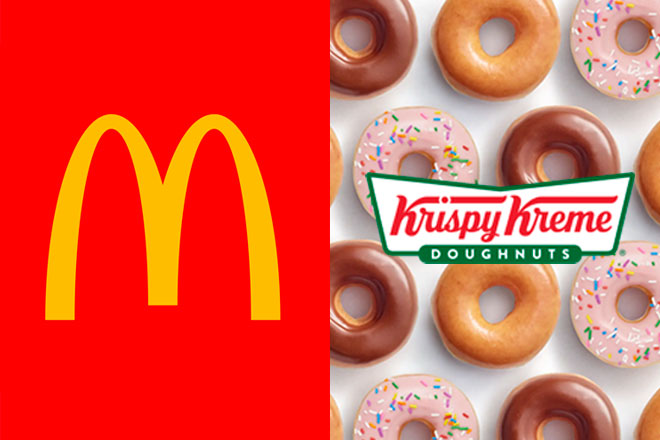How sweet is the McDonald’s/Krispy Kreme cross-promotion strategy?
Lots of people like McDonald’s. Lots of people like Krispy Kreme. But do they go together? That’s what we’ll find out once the newly announced (3/26/24) “expanded national partnership,” a cross-promotion strategy between these two major brands, goes from theory to reality, from limited test in Kentucky to nationwide rollout.
As America’s #1 Positioning Ad Agency, Innis Maggiore can’t sit around and wait for the results to come in. From a Positionist® standpoint, does it work — and does one partner benefit or risk more?
The knee-jerk reaction might be to question how doughnuts (that’s how Krispy Kreme spells it) fit into a hamburger joint. Turns out that McDonald’s launched breakfast 50 years ago and McCafé 30 years ago. The shock has likely worn off. On closer view, it’s more as if McDonald’s has nothing to lose. McDonald's sells nearly 8 million cups of coffee a day (which it says makes it the #2 coffee player globally). Sell a Krispy Kreme to only a fraction of that number and you get a tidy sum.
Krispy Kreme gains more on the surface in exposure, doubling its points of access by the end of 2026. The company’s stock share price showed an immediate jump of 29%, while McDonald’s remained virtually unchanged.
A fresh take on this is recommended.
Still, there’s something nagging about this cross-promotion strategy when viewed from a positioning perspective. A brand’s position is that one differentiating, defining factor that is central to its essence. Meaning, not the kind of thing with a lot of wiggle room.
Let’s go right to the source. Krispy Kreme proclaims to “make the most awesome doughnuts on the planet every single day.” The company has made these “sweet fluffy clouds of deliciousness” the way it always has — “the right way.” In all capital letters, the Krispy Kreme website sums it up as: “FUN. FRESH. WARM.” Ut-oh.
Krispy Kreme can make this promise for 377 locations, but what about 13,500 McDonald’s restaurants? According to Inc., Krispy Kreme had to dramatically turn things around after going through the fallout resulting from a drastic contrast in “quality, freshness, and taste” between their store-made doughnuts and packaged products sold in non-Krispy Kreme retail such as c-stores and grocery. Seems like Krispy Kreme may be risking the same self-imposed assault on its own brand position once again.
The company claims its hub and spoke model, hopefully dubbed the “Delivered Fresh Daily channel,” will mitigate that risk so that Krispy Kreme product will be “delivered fresh to McDonald’s restaurants every day.” Note that the press release announcing this cross-promotion strategy come to life underlined the word fresh, perhaps underscoring its own fear.
Eating your own words.
A Forbes article devoted to this cross-promotion strategy pointed out that strong brands can benefit from partnerships by gaining increased exposure, attracting new audiences, and generating new ideas. On the minus side, brands can risk alienating hardcore fans and diluting brand identity.
Krispy Kreme’s own words provide some clues. The company’s boilerplate language (such as that used in PR releases and news articles) describes the brand as “universally recognized for its hot-off-the-line, melt-in-your-mouth experience.” That sounds different from the experience post-shipment to thousands of McDonald’s. On the Krispy Kreme FAQ page, the company explains that it doesn’t ship its doughnuts to people, “because we cannot ensure the freshness and quality,” and as they “would not want our customers to receive inferior doughnuts.” Maybe McDonald’s customers getting something inferior to “hot-off-the-line and melt-in-your-mouth” is more acceptable.
We’re not questioning the truth of what Krispy Kreme intends, nor the merits of its hub and spoke model. However, from a positioning standpoint, you can sense the difference between good doughnuts made that day and starting that day fresh vs. the “most awesome doughnuts” that are “FUN. FRESH. WARM.” (Not the dreaded heat lamps!)
Unfortunately, we’ve learned that companies all too often take their eyes off of their brand’s position when tempted by the lure of the lucre:
- Will Krispy Kreme doughnut quality be equal at McDonald’s compared to its own stores? Of course not.
- Will Krispy Kreme knowingly compromise some of that quality by justifying that the product will be delivered fresh daily? Certainly.
- Will management and shareholders wave away the chance to double its points of access and eventually benefit from the further 10,000 new restaurants planned by McDonald’s by 2027? Not a chance.
- And will Krispy Kreme’s brand become diluted as a result? A big yes!
Innis Maggiore is America’s #1 Positioning Ad Agency, so we have the responsibility to take a stance on this cross-promotion strategy. While many might think that the concern could be about McDonald’s brand position, it turns out that Krispy Kreme is taking a much more substantial positioning risk in exchange for an offer as tempting as its doughnuts.
Ultimately, it could result in Krispy Kreme stores eventually become unnecessary, nostalgic relics of a “hot-off-the-line, melt-in-your-mouth” past. What do you think? Perhaps we’ll discuss it over a somewhat-fresh doughnut washed down by one of 8 million daily cups of coffee.



